Camouflage & Markings – Boulton Paul Defiant
Considered by some to be elegant, dismissed by others as one of the ugliest monoplane fighters of all time... the Defiant was a British two-seater built by Boulton Paul Aircraft as a "turret fighter", literally designed around a novel hydraulically-powered gun turret from the same company.
It has been claimed that the concept of a turret fighter related directly to the successful First World War-era Bristol F.2 Fighter, as if it somehow had made the concept of the Defiant obsolete from the very beginning. In fact, the concept of the powered armament turret was all the rage in the 1930s, and Boulton-Paul were the first British company to produce one that could be fitted into a single-engine aircraft. Its low profile caused a minimum of drag to the airframe, while the hydraulic variable gear system provided a very smooth operating movement in both traverse and elevation. The four Browning guns cleverly mounted in pairs on either side of the turret provided the firepower equal to most of the conventional fighters of the day (at the time there was no way of knowing what cannon armament would soon do to air fighting).
In combat, the Defiant was found to be effective - at its intended task of destroying bombers. The first operational sortie came on 12 May 1940, when the Defiants flew with six Spitfires of 66 Sqn, and a Ju 88 was shot down over the Netherlands. The following day, in a patrol that was a repetition of the first, Defiants claimed four Ju 87s, but were subsequently attacked by Bf 109Es. The escorting Spitfires were unable to prevent five of the six Defiants being shot down by a frontal attack. On 27 May, 264 Sqn claimed three He 111s and two damaged. On 28 May, shortly after take-off, ten Defiants were attacked by about 30 Bf 109s – forming a circle, they claimed six German fighters for the loss of three Defiants. The Defiant was initially successful against enemy aircraft and its best day was 29 May, when No. 264 Sqn claimed 37 kills in two sorties: 19 Junkers Ju 87 Stuka dive bombers, mostly picked off as they came out of their dives, nine Messerschmitt Bf 110 twin-engined heavy fighters, eight Bf 109s and a Ju-88. No. 264 Squadron claimed 48 kills in eight days over Dunkirk, but the the cost was high with 14 Defiants lost.
Lessons should have been learned from these statistics, but Fighter Command insisted on operating the Defiant in the No. 11 Group area which was notoriously infested by enemy fighters. Designed as a bomber-destroyer, the Defiant should have been operated in Scotland, in protection of the naval bases and the potential bomber threat from Norway, facing and destroying the unescorted Luftwaffe bombers and potentially relieving the Spitfire units stationed there.
As it was, the 19 July 1940 saw the combat debut of the second Defiant unit, No. 141 Sqn. Out of the nine Defiants sent to cover a convoy off Folkestone, seven were shot down by Bf 109s. With these losses, the Defiant — which had never been intended to fight alongside the Spitfires and the Hurricanes — was transferred to night fighter operations.
Enter all the black-painted profiles. By the time of the winter Blitz on London of 1940–41, night fighter operations were really in their infancy. Equipping four squadrons, the Defiant proved to shoot down more enemy aircraft than any other available type at the time. The Defiant crews developed a tactics of attacking the enemy bombers from below, in a similar manoeuvre to the later German Schräge Musik method. This was seen as confirmation of a turret-fighter concept for the night fighting role and the fitting of Defiant-type turrets to Beaufighter and Mosquito was tried to enable these aircraft to duplicate these methods. Eventually, the deleterious effect on performance proved too much and the idea was abandoned.
The up-rated Defiant Mk II model, designated solely for night-fighting, was fitted with the AI Mk. IV radar and a Merlin XX engine, distinguishable by its slightly longer cowling.
The Defiant was removed from combat duties in 1942, being supplanted in the night fighter role by the Bristol Beaufighter and de Havilland Mosquito. used for training, target towing, electronic countermeasures and air-sea rescue, as shown in the last profile of this set.
All profiles in this article have been drawn by Mr Rick Kent. Used by permission


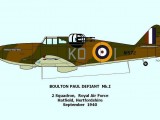
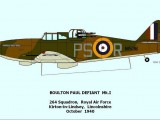
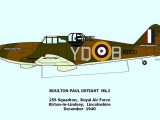
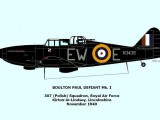
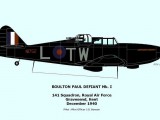
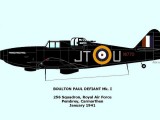
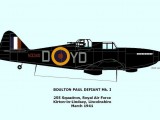

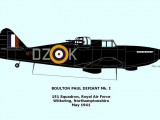
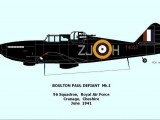
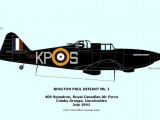
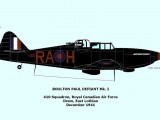
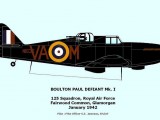
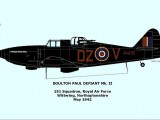
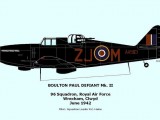
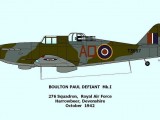
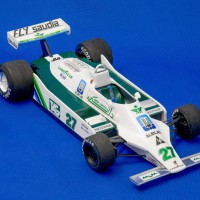

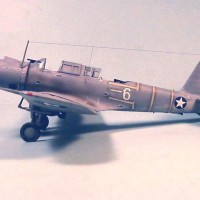
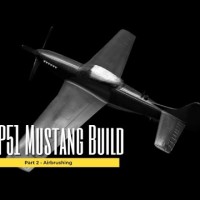
good inspiration for the new Airfix
That was the general idea 🙂
I was (am) one of the proponents of "ugly", but that scheme in black doesn't look too bad to me for some reason. And I assume that the main gear was awfully lengthy considering the antenna mounted beneath the fuselage.
Interesting point. Where do you put a wire antenna on such an aircraft... the front mast seems to have fit between the "normal" gear legs and the rear antenna must have been foldable.
http://plane-crazy.k-hosting.co.uk/Aircraft/WW2-Planes/Defiant/Defiant-1-+2.jpg
I'll buy that theory about "foldable", but they must have had to do it somehow AFTER takeoff, right? Thanks for the pic.
According to William Green, it retracted into the fuselage for landing and takeoff.
Perhaps integrated into the gear up/down control(s).
Nice article - thanks! I've finished a Defiant in the black bottom surface, but like Craig, think the all-black with low vis markings is nice - may do another!
Good article. Yep the nightfighter defiants with the red low vis markings have always looked good to me.
Greg, Anthony, thanks. The black looks a bit monotone in profiles, but in reality it also weathered quite heavily - could look great on a model
Excellent article Martin. It would seem that many armies and air forces are consigned to fight the last war with new technologies that are evolving but, not yet fully understood. The Defiant being a prime example. Still it is a worthy modeling subject and a footnote to evolution of fighter technology and tactics. Like the profiles they will come in handy for doing some of the new Airfix kits.
Who could resist an underpowered 30s designed aircraft that couldn't out-turn a bus, all in the face of the greatest military power since Napoleon.
Great post.
Rob, well and entertainingly put!
PS I just 'clocked' that the lead image was an aircraft from Martkesham Heath, Suffolk - I used to live a half hour from there.
Interesting. Is anything left of the RAF airfield there?
Martin, always good to get some good art work. Really enjoyed the information here, as this is not one of those popular / sexy aircraft (although interesting). It always amazes me the bravery of the guys who jumped into and fought with these early designs.
Hard to believe how one could squeeze into that turret with flight jacket and a parachute suit on...
Martin, my sincere admiration to Rick Kent. That's the most sideviews I've ever seen on the aircraft. Thanks for showing them to us now that there are really good readily available kits in two scales.
Rick was kind to share with me many more of of his drawings, so more is to come. I can witness of the quality of his work and the underlying research.
Nice article Martin, enjoyed reading about a rather unique aircraft.
Thanks, Tom
I don't think it's ugly at all. Thanks for the great info.
Thanks Robert, I share your appreciation of the Defiant's aesthetics.